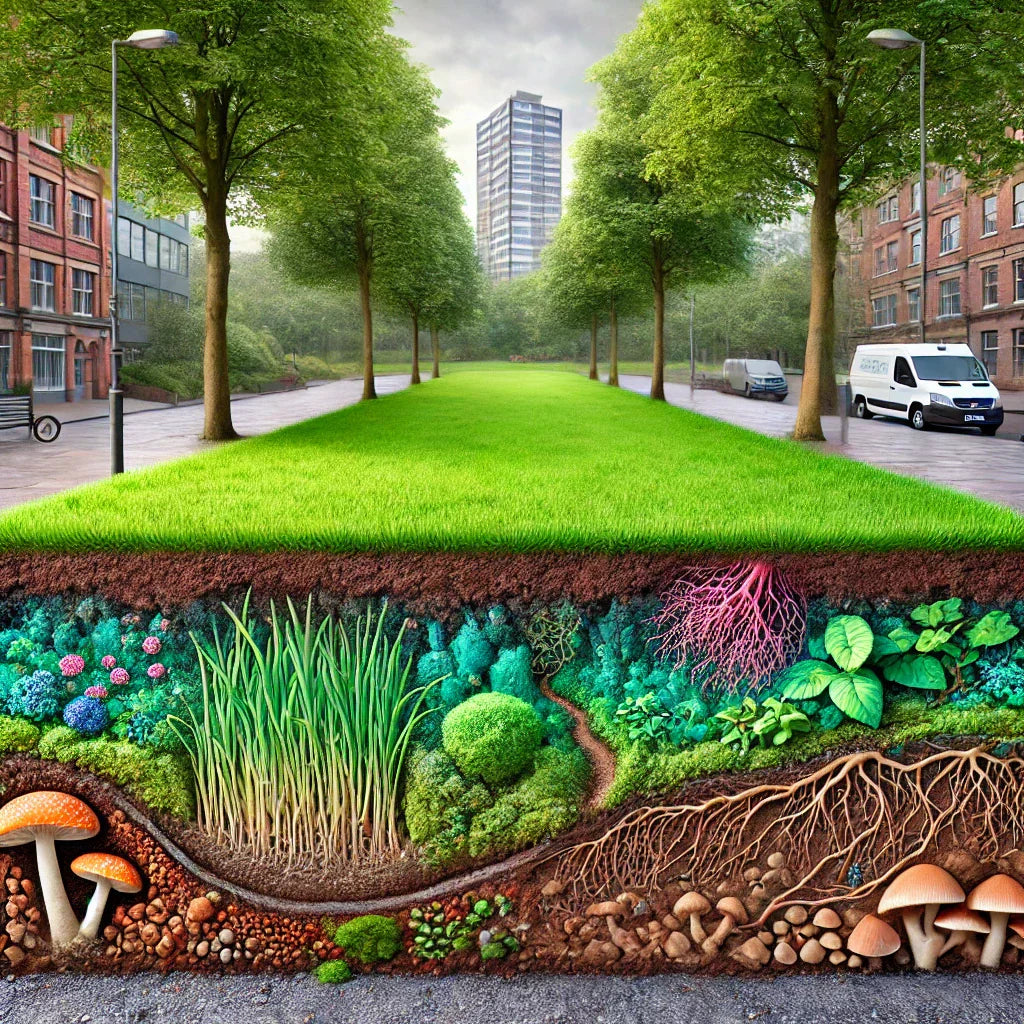
Unlocking Urban Soil’s Hidden Potential: Biological Soil Assays for Carbon Sequestration in Sheffield & South Yorkshire
Share
How Businesses and Councils Can Improve Soil Health, Biodiversity, and Sustainability
Urban soil is one of the most overlooked solutions to climate change and biodiversity loss. Yet, beneath our feet lies a powerful tool for carbon sequestration, urban cooling, and ecosystem restoration—if we treat it right.
For businesses and local councils in Sheffield and South Yorkshire, improving soil health isn’t just about being green—it’s about meeting sustainability targets, improving community spaces, and accessing grants to fund environmental initiatives.
Using biological soil assays, organizations can measure and improve their soil’s ability to store carbon, retain water, and support microbial and fungal life. By investing in soil health, councils and businesses can demonstrate environmental responsibility without massive financial investment—and even secure funding to support these efforts.
In this guide, we’ll explore:
✅ What biological soil assays are and how they improve soil carbon storage
✅ The difference between dead soil (dirt) and living soil for carbon sequestration
✅ Available grants and funding for businesses and councils to improve soil health
✅ How improving soil health supports Sheffield and South Yorkshire’s net-zero goals
What Are Biological Soil Assays? How Do They Improve Soil Health?
A biological soil assay is a test that measures the microbial and fungal activity in soil. These tests provide critical data on:
✔ Soil organic matter content (how much carbon the soil holds)
✔ Fungal and bacterial diversity (the microbes responsible for carbon storage)
✔ Soil structure and aggregation (which improves water retention and reduces erosion)
By analyzing soil health, councils and businesses can make data-driven decisions about soil restoration efforts, leading to healthier urban environments, reduced carbon emissions, and improved biodiversity.
Healthy Soil vs. Dead Soil: Why It Matters for Carbon Storage
Soil is one of the Earth’s largest carbon sinks. However, the amount of carbon stored in soil depends on its biological activity. Living soil, rich in fungi and microbial life, can store up to five times more carbon than degraded, compacted urban soil ("dirt").
| Soil Type | Microbial Life | Carbon Storage Potential | Water Retention | Erosion Risk |
|---|---|---|---|---|
| Dead Soil ("Dirt") | Minimal to none | Low (carbon lost as CO₂) | Poor, dries out quickly | High |
| Living, Fungi-Rich Soil | High (thriving microbes & fungi) | High (carbon stored in organic matter & glomalin) | Excellent, reduces flooding | Low |
The Role of Fungi & Glomalin in Carbon Storage
One of the most important contributors to soil carbon sequestration is glomalin, a glycoprotein produced by arbuscular mycorrhizal fungi.
🔬 Glomalin acts like a carbon glue, binding organic matter to soil particles and increasing the soil’s ability to hold carbon long-term. Research suggests that up to 30% of carbon stored in soil is locked in by glomalin.
🛑 Without fungi and glomalin, urban soil rapidly loses its carbon stores—releasing CO₂ into the atmosphere instead of locking it away underground.
Grants & Subsidies Available for Soil Health & Carbon Sequestration in Sheffield & South Yorkshire
The UK government and local funding bodies recognize the importance of carbon sequestration and biodiversity. As a result, businesses and councils can access funding to support soil health projects.
1️⃣ Low Carbon - Community and Culture Project
✅ Funded by: UK Shared Prosperity Fund
✅ Total available funding: £600,000
✅ Grant amount: Up to £20,000 per project
✅ Who can apply? Community & cultural organizations improving environmental impact
🔗 More info & application
2️⃣ £3.4 Million SME Carbon Reduction Fund
✅ Funding for small & medium-sized businesses in Sheffield, Barnsley, Doncaster, and Rotherham
✅ Support to help businesses reduce carbon footprints & improve sustainability
✅ Available until March 2025
🔗 More info & application
By securing funding for biological soil assessments and restoration, councils and businesses can improve soil health with minimal financial investment, while demonstrating real environmental action.
Soil Carbon Sequestration & Sheffield’s Net-Zero 2040 Goal
Sheffield and South Yorkshire have committed to achieving net-zero carbon emissions by 2040. While urban soil restoration is still an emerging field in carbon accounting, improving soil health can contribute to this target by:
✔ Locking atmospheric CO₂ into soil organic matter
✔ Reducing urban heat islands (improving climate resilience)
✔ Enhancing urban green spaces for biodiversity & sustainability
Can Soil Carbon Sequestration Count Towards Official Carbon Offsets?
Currently, soil carbon sequestration is not widely included in formal carbon credit schemes, but many sustainability programs recognize soil health as a key environmental metric. Businesses and councils can still showcase their soil restoration efforts as a tangible, science-backed sustainability initiative.
How to Get Started: Simple Steps for Businesses & Councils
✅ 1. Conduct a Biological Soil Assay – Understand your soil’s current carbon storage potential.
✅ 2. Apply for Available Grants & Funding – Use financial support to implement soil health projects.
✅ 3. Implement Soil Regeneration Techniques – Introduce fungal inoculants, compost applications, and no-dig practices.
✅ 4. Showcase Your Impact – Use data from soil testing to demonstrate measurable carbon sequestration & sustainability leadership.
By following these steps, businesses and councils can improve soil health, contribute to climate goals, and access funding—all while demonstrating real environmental impact.
Final Thought: Why Your Soil Matters
Urban soil is more than just dirt—it’s a powerful carbon sink, a biodiversity hub, and a key player in climate resilience.
🌍 If you’re walking on compacted, lifeless dirt, you’re standing on a missed opportunity. With a small investment in biological soil assays and restoration, Sheffield and South Yorkshire can transform urban soils into thriving, carbon-locking ecosystems.